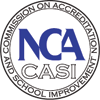
 |
|
Vision
The governing board, working with the school staff and community, develops
and maintains a written statement of mission and goals to be served by the
educational program. The mission and goals of the district are reflected at the
building level.
|
Membership Criteria | |
| VL 1 | There is a written statement of the school's beliefs about the nature of young people, the learning process, and the commitments of the school community in promoting student learning. |
| VL 2 | There is a written statement of the school's mission and goals, consistent and compatible with the mission and goals of the district governing board, which is the governing document for the school and its programs. |
| VL 3 | The school's mission and goals statement is developed through appropriate participation by the school staff, parents, students, and community representatives. |
|
Improvement Criteria | |
| VL 4 | The mission and goals statement clarifies the purpose of the school. |
| VL 5 | Provision is made for annual review and, when necessary, modification of the mission and goals statement. |
Leadership-Governance
|
Membership Criteria | |
| VL 10 | There is a school or district governing board that develops policies appropriate to the needs of the school/district. Whether elected or appointed, representatives on the governing board represent the interests of the school community. |
| VL 11 | Individual board members do not engage in transactions for the school/district without prior and specific authorization by a majority of the governing board. |
| VL 12 | The school is part of a system with a superintendent who is responsible for providing effective educational leadership and administering the school/district in accordance with governing board policies. Unit schools shall employ a full-time administrator. Schools in systems that employ a single superintendent for two or more districts and have a full-time principal employed in each school may be considered in compliance with this criterion, subject to the approval of the state committee. |
| VL 13 | The working relationship between the governing board and the superintendent establishes a climate for articulating and promoting the educational vision of the district in the school community. |
| VL 14 | The superintendent works to mobilize the entire school community to provide high quality education for students. |
| VL 15 | The governing board, superintendent, and district-level administration work to secure resources to support continued improvement initiatives in the school/district. |
| VL 16 | The school has a principal responsible for organizing the school's program to improve student performance. The principal has the authority and resources to accomplish this goal. |
| VL 17 | The working relationship between the superintendent and principal facilitates the effective operation of the school in pursuit of its mission. |
| VL 18 | The principal, staff, and community work together to accomplish the mission and attain the goals of the school. |
| VL 19 | The working relationship between the principal and staff facilitates a school climate that supports innovation and creativity in helping all students achieve the specified learning goals. |
School
Community
The school establishes meaningful relationships with its community to promote
and enhance the achievement of the school's learning goals.
|
Membership Criteria | |
| VL 25 | There is a planned public communications program using a variety of media to inform the school community about the goals, programs, and results of the school's improvement efforts. |
|
Improvement Criteria | |
| VL 26 | The school community works to provide the highest quality education for its students. |
| VL 27 | There is a planned and functioning program whereby community resources are identified and utilized for the enhancement of the curricular program in achieving the goals of the school. |
| VL 28 | The school provides students with the opportunity to use newly acquired academic skills and knowledge in real-life service-learning experiences that address actual community needs. |
|
All material on this site © 2000-02 NCA Commission on
Accreditation and School Improvement unless otherwise noted. |
|